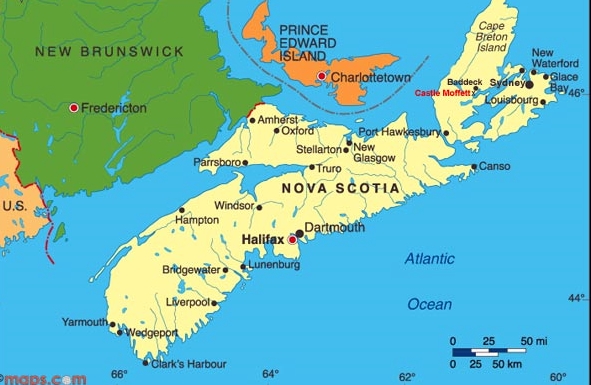Halifax, Titanic, Immigration and on to Moncton
Sunday, July 9 Halifax to Moncton
We began the day with a drive around Halifax to understand the geography and hear a talk of the history here. That history is one of continued conflict between Britain and France with fascinating references to European history, including Napoleon. The history also goes to the 20th c. regarding prohibition and the World Wars. One interesting story revolves around the two tiny islands of Miquelon and St. Pierre which are part of France, but are located off of the southern coast of Newfoundland. Alcoholic beverages were legal there while illegal in the USA, and there was apparently an armada of boats based in Halifax which ran liquor and wine from France via St. Pierre and Miquelon to the northeast USA. A Google search on “prohibition” and “St. Pierre” gets lots of web sites which tell the story.
We then visited a local cemetery where there are more than 150 victims of the sinking of the Titanic buried, some of which have no names. As most of us remember, the Titanic sank after hitting an iceberg on the night of April 14, 1912. Almost 1500 lives were lost, and of those only 328 bodies were recovered. Many were buried at sea, but the remaining ones were brought to Halifax where families then had to pay to reclaim the bodies and ship them home. As many were unable to do so, and as many were unidentified, more than 150 are buried in three cemeteries here. A small number are in each of the Jewish and the Catholic cemeteries, and the bulk are here, in graves laid out so that the headstones form the shape of a ship. The shipping company paid for the burials and the very simple stones. Each stone is numbered with the sequence number of the recovery of the body, and is labeled simply “died” and the date:
If the name is known it is added, and if the family wished to pay for it, a fancier headstone could be added.
We heard stories of identification which continue until recent years, with exhumation of bodies and DNA investigations. It’s quite a story.
We also heard an account of the very large number of airplanes which landed in Halifax on 9/11 when the US airspace was shut down, stranding thousands of people with no luggage (which was all left on the planes). Our guide and his family hosted a US couple for five days before they were able to get home.
Our last stop in Halifax was at Pier 21, a complex comparable to our Ellis Island, where we learned the story of immigration to Canada. At the entrance to the facility is a striking memorial to the failure of immigration policy, telling the story of the ship St. Louis, carrying hundreds of German Jews fleeing the Nazi regime. The memorial, designed by Daniel Libeskind, is called the “Wheel of Conscience” and consists of four moving intermeshed gears labeled Hatred, Racism, Xenophobia and Antisemitism. The accompanying story of the ship is told, with the rejection by Cuba, the USA and Canada leading to the return of the passengers to Germany and the ultimate murder of many of them during the Holocaust. It makes a striking beginning to the story of modern Canadian immigration policy, especially with reference to refugees.
We spent a couple of hours at the exhibits which were very well-done. After lunch we left Halifax and traveled to Moncton in New Brunswick, learning about this province as we traveled. There’s lots to know, but one interesting fact stood out: Canada allows each province to determine if it will be mono-lingual or bilingual in French and English. Only one province is bilingual formally and legally, and that is New Brunswick! The bulk of the residents of New Brunswick are bilingual, and there is a very large French-speaking population here, but most French speakers also speak English! I had no idea.
Tomorrow to Hopewell Rocks.







Fascinating--so many important historical events and trends touched down (like that US airplane) in Halifax.
ReplyDelete--I was struck by the gravestones: they don't look a hundred years old. I wonder if they've been scrupulously maintained or actually replaced at some point.
--How strange for a city, to be the place where strangers get stranded (or turned away, etc.), again and again. Well, I guess that's part of near the eastern edge of the continent (though Newfoundland is yet further east).
--Very interesting fact about French speakers, and French speaking, in New Brunswick. Really, ethnicity and ethnic identity are complex matters!
I am surprised they didn't touch on the explosion of the munitions ship in WWII. It wiped out almost every building fronting on the harbor and a couple of block inland. Many people died. There is a museum devoted to the story. Halifax is the largest North American Atlantic sea port and the damage was devastating to the war effort for an extended period while they rebuilt. I also didn't realize provinces could opt out of bilingualism, of course with the exception of Quebec.
ReplyDeleteI am anxious to hear about Moncton. Mostly I know they have a hockey team, but then who doesn't in Canada.
We were indeed taught about the explosion. It's quite a story, and we heard many details.
DeleteNew Brunswick is the ONLY officially bilingual province. Quebec is officially monolingual French and does only what it is required to do to cater to the English-speakers. All the other provinces are officially monolingual English and do only what they are required to do to cater to the French-speakers. In only New Brunswick are both languages officially equal.